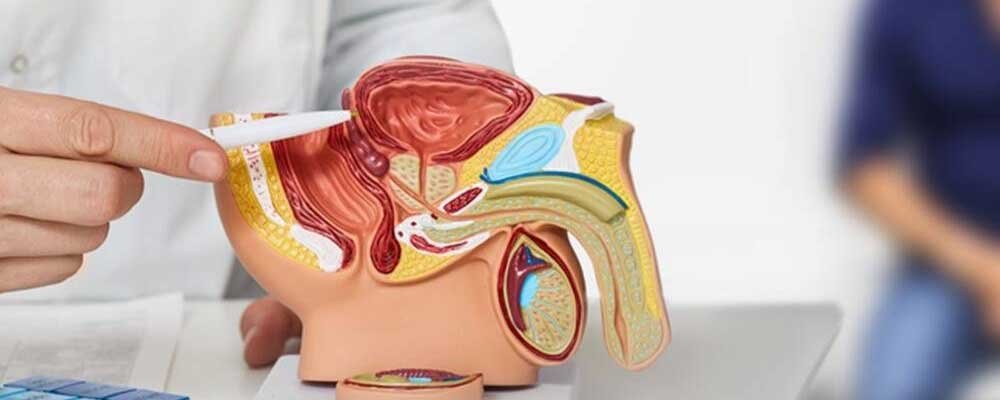Prostate enlargement, also known as benign prostatic hyperplasia (BPH), is a common condition among older men that can cause urinary symptoms such as difficulty starting and stopping urination, weak urine flow, and frequent urination. While lifestyle changes can help manage BPH symptoms, medical treatments can also be effective for more severe cases. However, like any medical treatment, they come with both pros and cons.
HERE IS A DETAILED OVERVIEW OF SOME OF THE SURGICAL OPTIONS FOR PROSTATE ENLARGEMENT:
Transurethral Resection of the Prostate (TURP): TURP is the most common surgical procedure for prostate enlargement. This procedure involves the insertion of a small instrument called a resectoscope into the urethra and is used to remove the excess prostate tissue that is blocking urine flow. The procedure is usually performed under general or spinal anesthesia and takes about an hour to complete. TURP is considered a safe and effective procedure, with a low risk of complications. However, some men may experience temporary side effects such as bleeding, urinary incontinence, or difficulty urinating. Recovery time is typically 2-4 weeks.
Holmium Laser Enucleation of the Prostate (HoLEP): HoLEP is a newer advanced minimally invasive surgical option for prostate enlargement. During this procedure, a laser is used to remove the excess prostate tissue, allowing urine to flow more freely. HoLEP is often performed under general or spinal anesthesia and may take up to 2 hours to complete. The advantages of HoLEP include a lower risk of bleeding and shorter hospital stays. However, it may not be suitable for men with very large prostate glands or certain medical conditions. Recovery time is typically 1-2 weeks.
Both laser prostate surgery and transurethral resection of the prostate (TURP) are effective surgical options for treating prostate enlargement. However, there are some advantages of laser prostate surgery over TURP:
- Lower Risk of Bleeding: Laser prostate surgery may have a lower risk of bleeding compared to TURP, which involves cutting and removing tissue using a wire loop. This is because laser surgery can precisely target and remove only the affected tissue, without damaging surrounding tissue.
- Shorter Hospital Stay: Patients who undergo laser prostate surgery may be able to go home on the same day or within 24 hours after the procedure, whereas TURP often requires a longer hospital stay.
- Faster Recovery Time: Laser prostate surgery may have a faster recovery time compared to TURP, with patients able to return to their normal activities sooner. This is because laser surgery is less invasive and causes less trauma to the surrounding tissue.
- Lower Risk of Complications: Laser prostate surgery may have a lower risk of complications such as urinary incontinence or erectile dysfunction compared to TURP. This is because laser surgery can more precisely target the affected tissue and minimize damage to surrounding tissue.

Prostatectomy: Prostatectomy is a surgical procedure that involves removing the entire prostate gland. This procedure is typically reserved for men with very large prostate glands or those with prostate cancer. Prostatectomy can be performed using traditional open surgery, laparoscopic surgery, or robot-assisted surgery. The advantages of prostatectomy include a lower risk of recurrence compared to other surgical options. However, it also has a higher risk of complications such as bleeding, infection, urinary incontinence, or erectile dysfunction. Depending on the type of operation, recovery time might vary.
Transurethral Incision of The Prostate (TUIP): TUIP is a minimally invasive surgical option for prostate enlargement that involves making small incisions in the prostate gland to relieve pressure on the urethra. This procedure is usually performed under local or spinal anesthesia and takes about 30- 60 minutes to complete. The advantages of TUIP include a shorter recovery time compared to TURP or prostatectomy, and a lower risk of complications such as bleeding or urinary incontinence. However, it may not be suitable for men with very large prostate glands or certain medical conditions.
Transurethral Microwave Thermotherapy (TUMT): TUIP is a minimally invasive surgical option for prostate enlargement that involves making small incisions in the prostate gland to relieve pressure on the urethra. This procedure is usually performed under local or spinal anesthesia and takes about 30-60 minutes to complete. The advantages of TUIP include a shorter recovery time compared to TURP or prostatectomy, and a lower risk of complications such as bleeding or urinary incontinence. However, it may not be suitable for men with very large prostate glands or certain medical conditions.
Transurethral Needle Ablation (TUNA): TUNA is a minimally invasive procedure that uses radiofrequency energy to destroy excess prostate tissue. This procedure is usually performed under local anesthesia and takes about 30-60 minutes to complete. The advantages of TUNA include a shorter recovery time compared to TURP or prostatectomy, and a lower risk of complications such as bleeding or urinary incontinence. However, it may not be suitable for men with very large prostate glands or certain medical conditions.

THERE ARE SEVERAL NEWER MODALITIES OF TREATMENT FOR PROSTATE ENLARGEMENT THAT HAVE EMERGED IN RECENT YEARS, SOME OF WHICH INCLUDE:
UroLift: This is a minimally invasive procedure that involves the insertion of small permanent implants into the prostate to lift and hold the enlarged tissue away from the urethra, reducing urinary symptoms. UroLift is a relatively quick procedure that can be performed as a daycare procedure and typically involves minimal pain and discomfort.
Aquablation: This is a robotic-assisted procedure that uses a high-velocity waterjet to remove prostate tissue. The waterjet is controlled by a computer, which helps to ensure the precise removal of the tissue while minimizing damage to surrounding structures.
Rezum: This is a minimally invasive procedure that involves the injection of steam into the prostate to destroy the excess tissue causing the enlargement. Rezum is typically performed under local anesthesia in an outpatient setting and involves minimal discomfort and downtime.
It's important to note that the choice of treatment option depends on individual factors such as the size and severity of the prostate enlargement, as well as any other medical conditions the patient may have. Your urologist can help you determine the most appropriate treatment option for your situation.

Some potential risks associated with any surgical procedure for prostate enlargement may include bleeding, infection, urinary incontinence, erectile dysfunction, or retrograde ejaculation (when semen flows back into the bladder instead of out through the penis during ejaculation). Your healthcare provider will discuss the potential risks and benefits of each surgical option with you, and help you decide which option is best for your situation.
After surgery, it is important to continue to follow a healthy lifestyle and monitor your symptoms. Some men may experience temporary side effects such as urinary urgency, frequency, or burning. However, these usually resolve within a few weeks to months. It's important to attend all follow-up appointments with your urologist and report any persistent or new symptoms. In some cases, additional treatment may be necessary to manage any ongoing issues.
In summary, surgical options for prostate enlargement can provide significant relief for men who have not responded to other treatments or whose symptoms have progressed to a point where surgery is necessary. It's important to understand the risks and benefits of each surgical option and to work closely with the urologist to determine the best course of treatment for your individual needs. With proper care and support, men can successfully manage prostate enlargement and improve their quality of life.

Dr. Amit Goel is a Consultant Laparoscopic/ Robotic Urologist & Renal Transplant Surgeon. He has over 15 years of experience in successfully treating complex urological diseases. His expertise includes diagnosing & treating Kidney stones, prostate enlargement, prostate cancer, kidney cancer, bladder cancer & incontinence, male infertility & erectile dysfunction.
